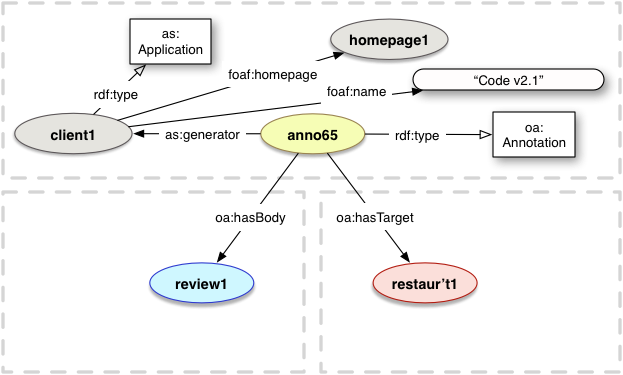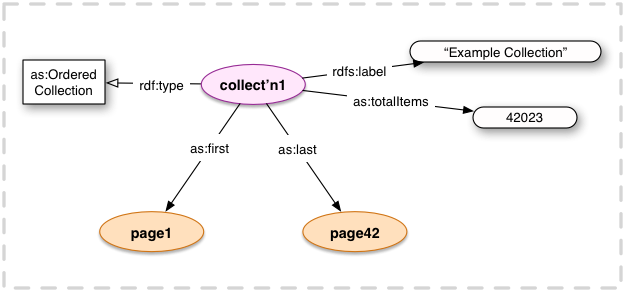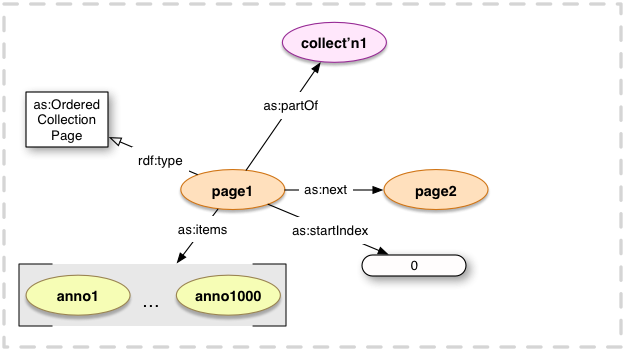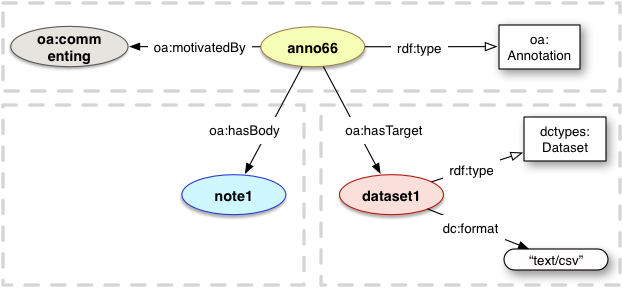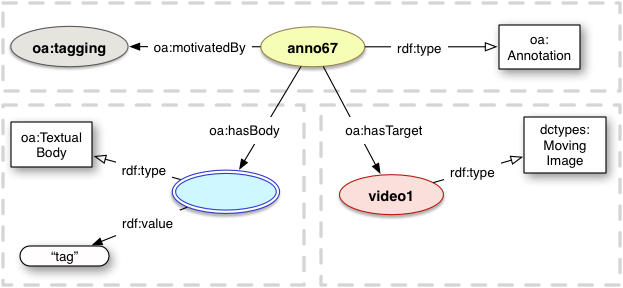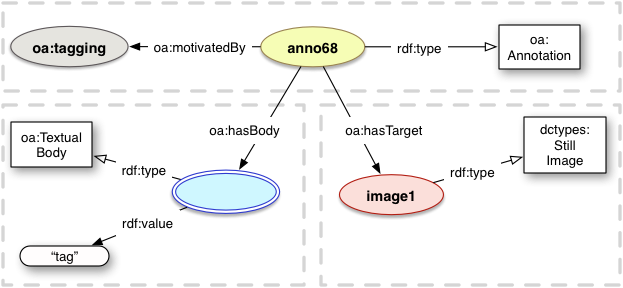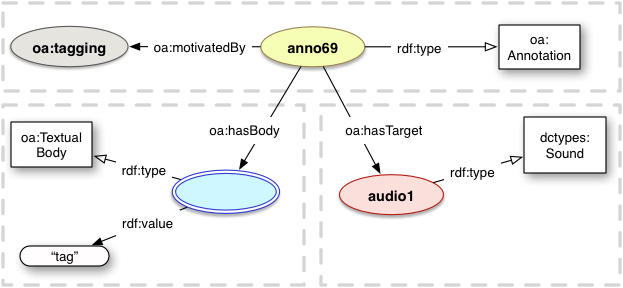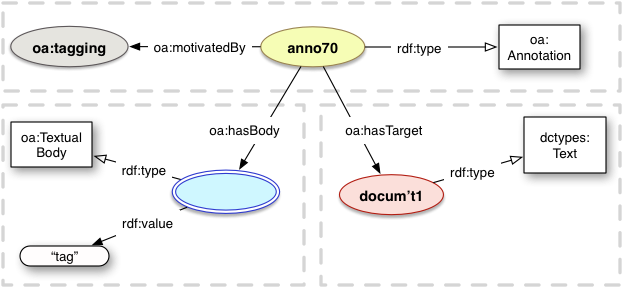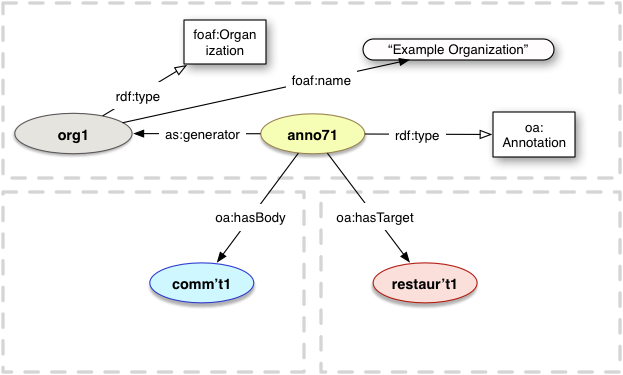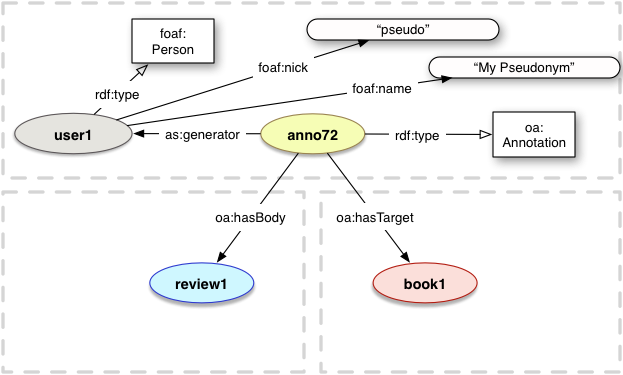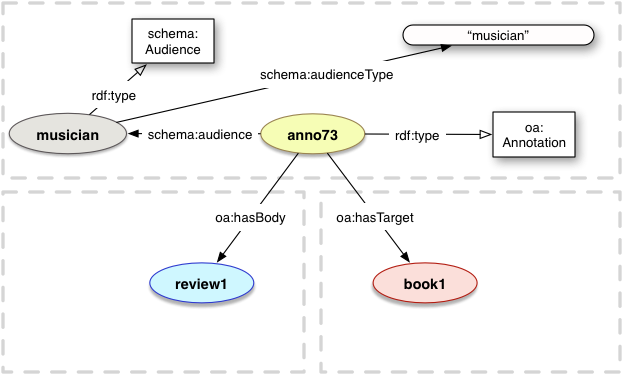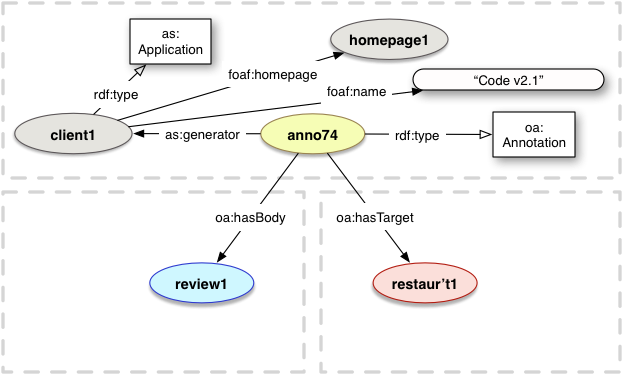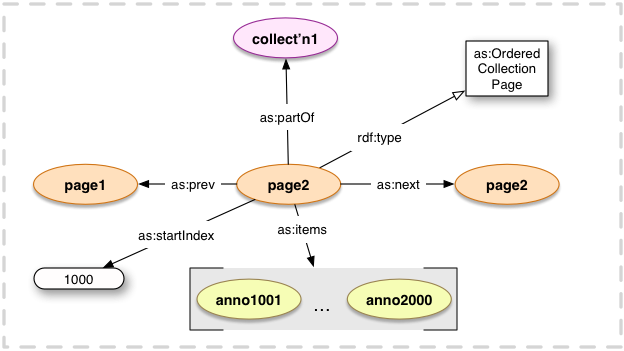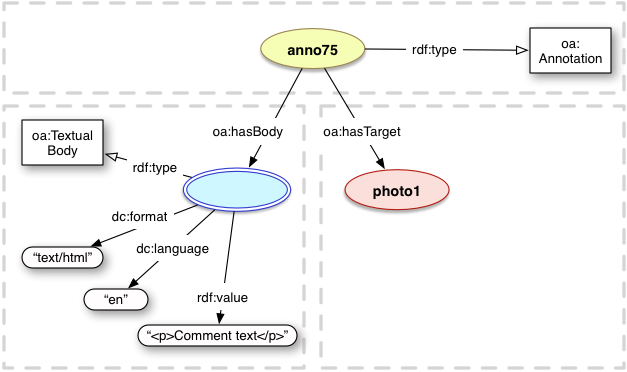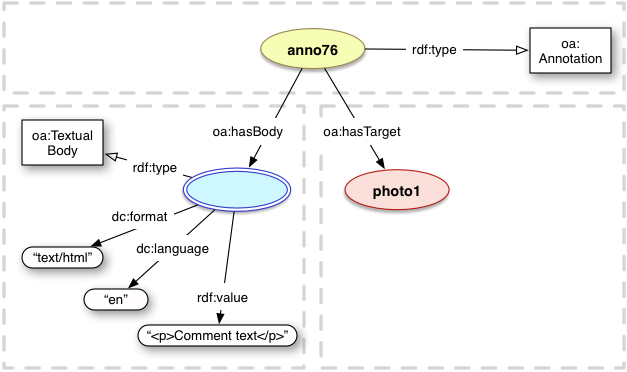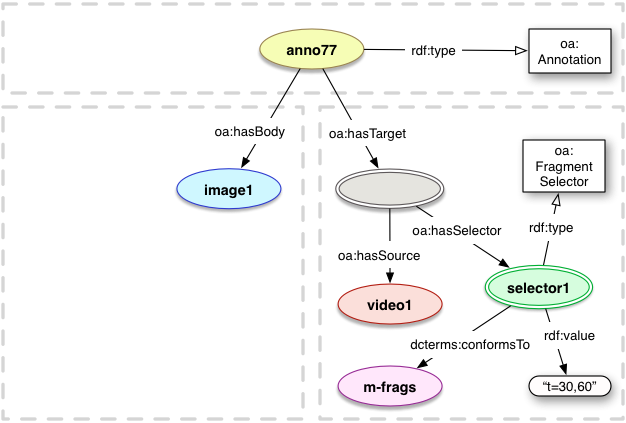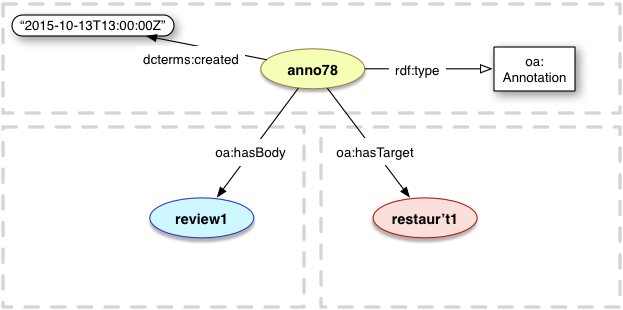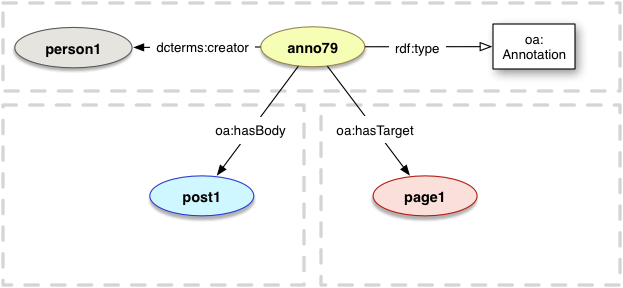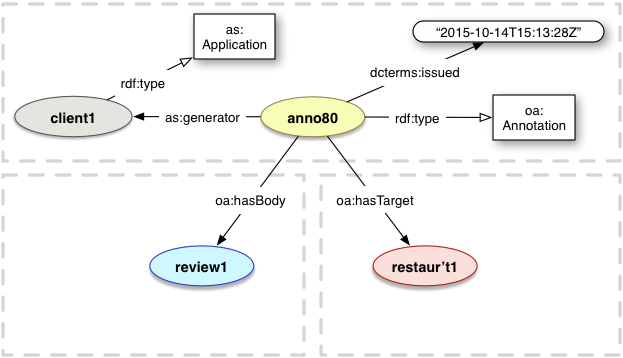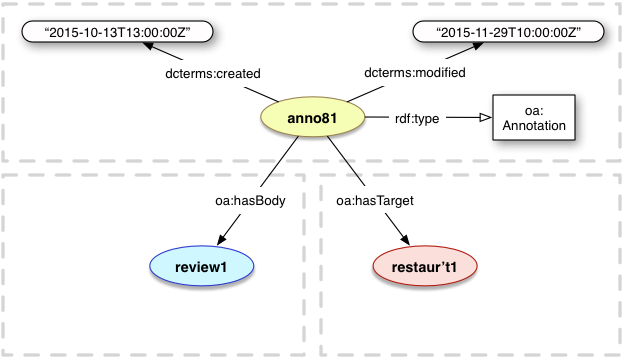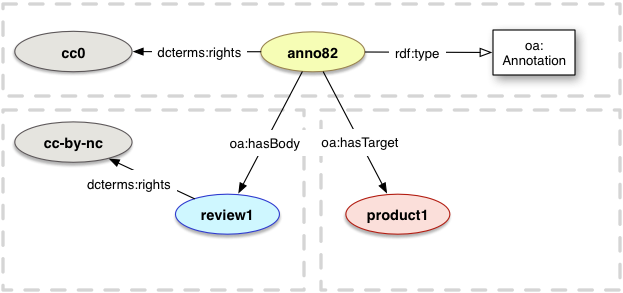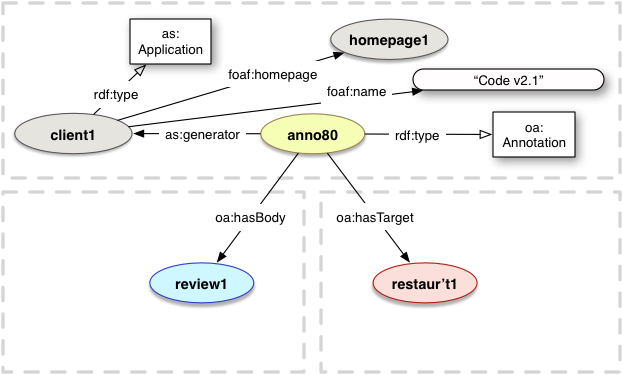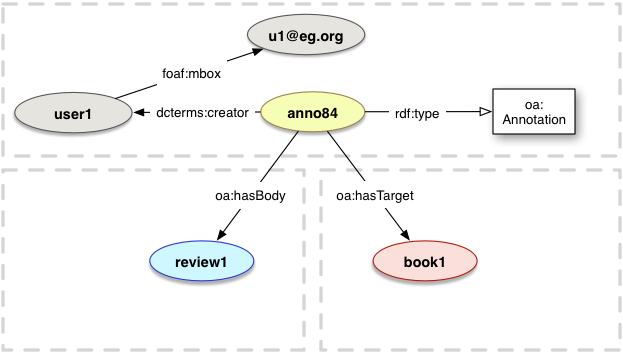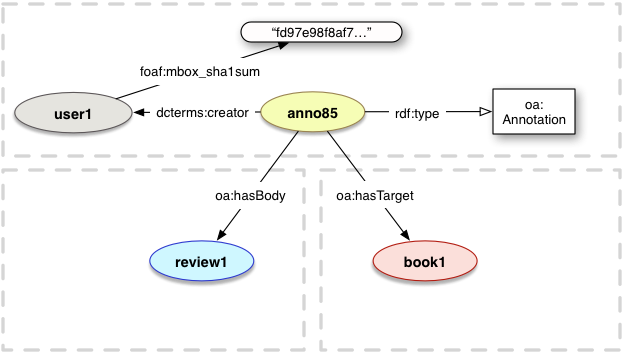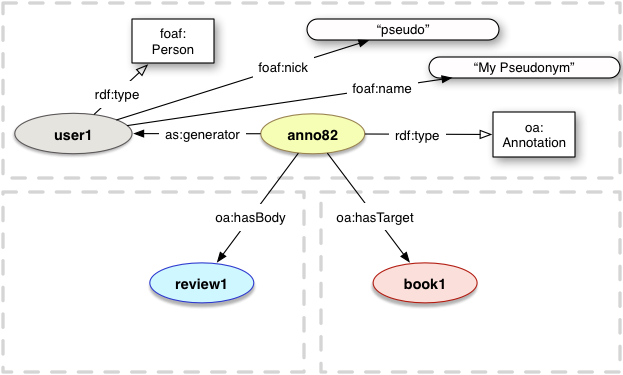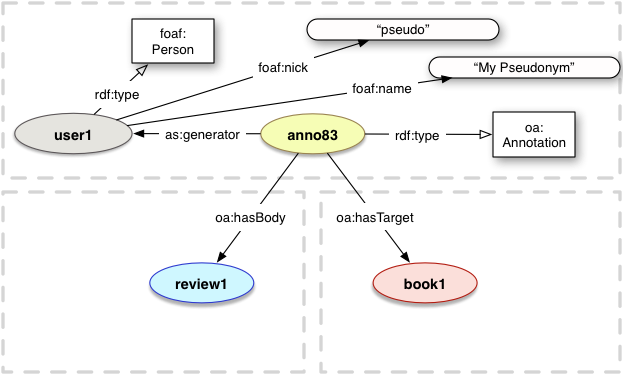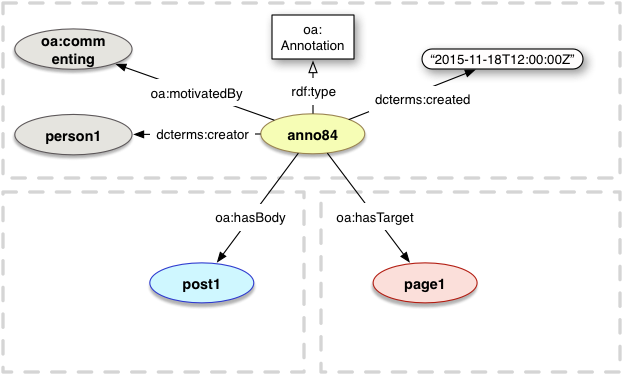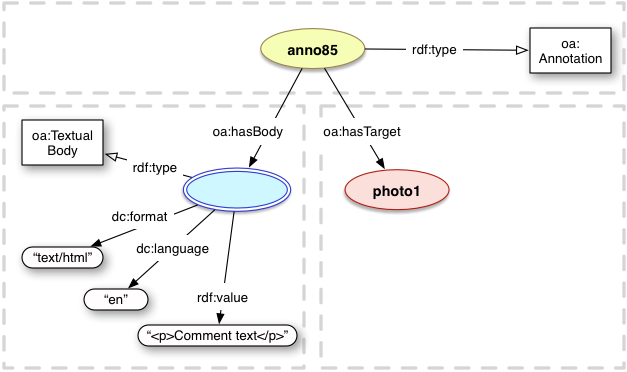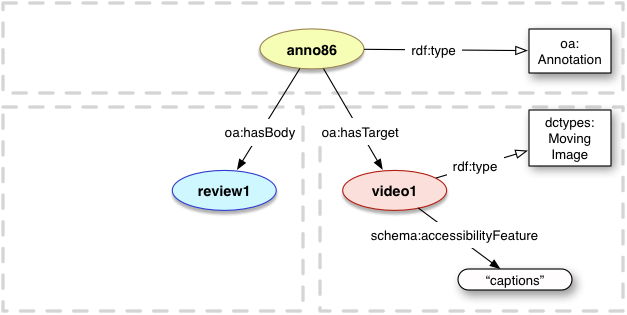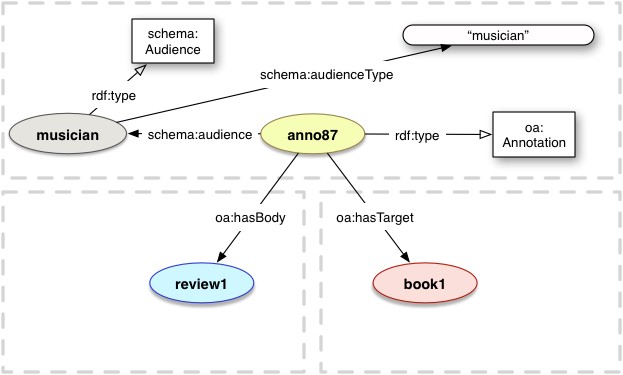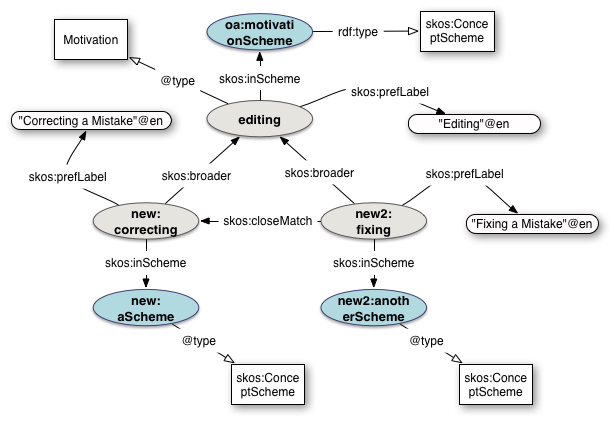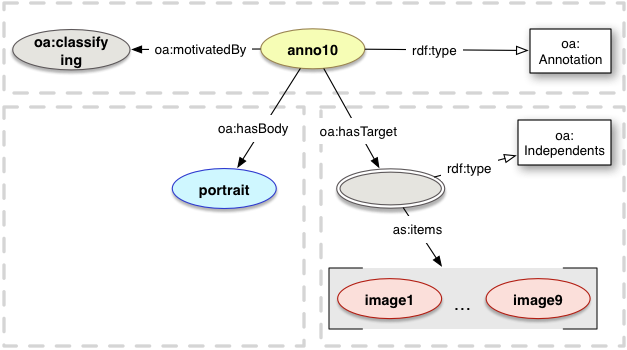Web Annotation Ontology
The namespace used for the Web Annotation Ontology is:http://www.w3.org/ns/oa#
Classes
Annotation
The class for Web Annotations.
- IRI: http://www.w3.org/ns/oa#Annotation
- Required Predicates: oa:hasTarget, rdf:type
- Recommended Predicates: oa:hasBody, oa:motivatedBy, dcterms:creator, dcterms:created
- Other Predicates: oa:bodyValue, oa:styledBy, dcterms:issued, as:generator

<http://example.org/anno1> a oa:Annotation ; oa:hasBody <http://example.org/post1> ; oa:hasTarget <http://example.com/page1> ; oa:motivatedBy oa:commenting ; dcterms:creator <http://example.org/person1> ; dcterms:created "2015-11-18T12:00:00Z" .
Choice
A subClass of as:OrderedCollection that conveys to a consuming application that it should select one of the resources in the as:items list to use, rather than all of them. This is typically used to provide a choice of resources to render to the user, based on further supplied properties. If the consuming application cannot determine the user's preference, then it should use the first in the list.
- IRI: http://www.w3.org/ns/oa#Choice
- Sub Class Of: as:OrderedCollection
- Required Predicates: as:items, rdf:type

<http://example.org/anno2> a oa:Annotation ; oa:hasTarget <http://example.org/site1> ; oa:hasBody [ a oa:Choice ; as:items (<http://example.org/note1> <http://example.org/note2>) ] . <http://example.org/note1> dc:language "en" . <http://example.org/note2> dc:language "fr" .
CssSelector
A CssSelector describes a Segment of interest in a representation that conforms to the Document Object Model through the use of the CSS selector specification.
- IRI: http://www.w3.org/ns/oa#CssSelector
- Sub Class Of: oa:Selector
- Required Predicates: rdf:value, rdf:type
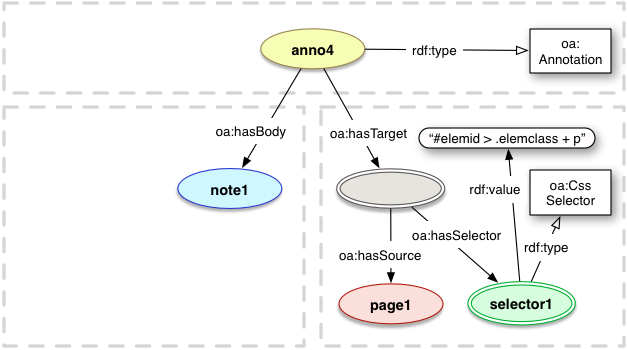
<http://example.org/anno3> a oa:Annotation ; oa:hasBody <http://example.org/note1> ; oa:hasTarget [ oa:hasSource <http://example.org/page1> ; oa:hasSelector [ a oa:CssSelector ; rdf:value "#elemid > .elemclass + p" ] ] .
CssStyle
A resource which describes styles for resources participating in the Annotation using CSS.
- IRI: http://www.w3.org/ns/oa#CssStyle
- Sub Class Of: oa:Style
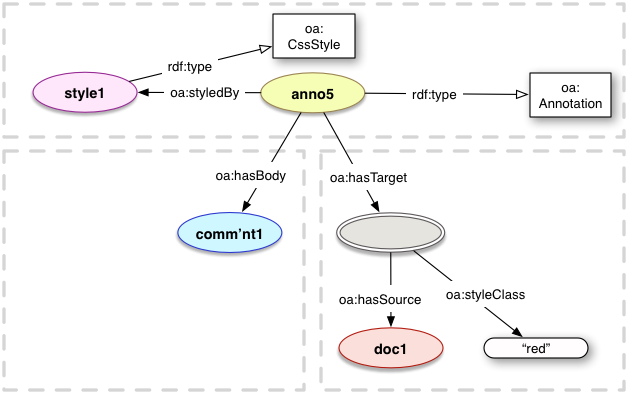
<http://example.org/anno4> a oa:Annotation ; oa:hasBody <http://example.org/comment1> ; oa:styledBy <http://example.org/style1> ; oa:hasTarget [ oa:hasSource <http://example.org/document1> ; oa:styleClass "red" ] . <http://example.org/style1> a oa:CssStyle .
DataPositionSelector
DataPositionSelector describes a range of data by recording the start and end positions of the selection in the stream. Position 0 would be immediately before the first byte, position 1 would be immediately before the second byte, and so on. The start byte is thus included in the list, but the end byte is not.
- IRI: http://www.w3.org/ns/oa#DataPositionSelector
- Sub Class Of: oa:Selector
- Required Predicates: rdf:type, oa:start, oa:end
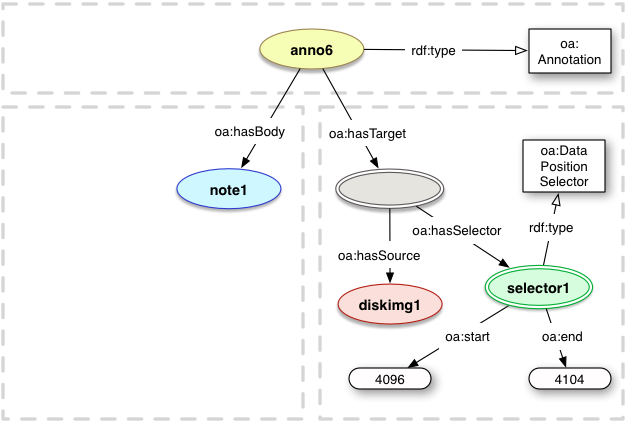
<http://example.org/anno5> a oa:Annotation ; oa:hasBody <http://example.org/note1> ; oa:hasTarget [ oa:hasSource <http://example.org/diskimg1> ; oa:hasSelector [ a oa:DataPositionSelector ; oa:start 4096 ; oa:end 4104 ] ] .
Direction
A class to encapsulate the different text directions that a textual resource might take. It is not used directly in the Annotation Model, only its three instances.
- IRI: http://www.w3.org/ns/oa#Direction

<http://example.org/anno6> a oa:Annotation ; oa:hasBody [ rdf:value "This is a comment" ; dc:language "en" ; dc:format "text/plain" ; oa:textDirection oa:ltr ] ; oa:hasTarget <http://example.org/page1> .
FragmentSelector
The FragmentSelector class is used to record the segment of a representation using the IRI fragment specification defined by the representation's media type.
- IRI: http://www.w3.org/ns/oa#FragmentSelector
- Sub Class Of: oa:Selector
- Required Predicates: rdf:value, rdf:type
- Recommended Predicates: dcterms:conformsTo
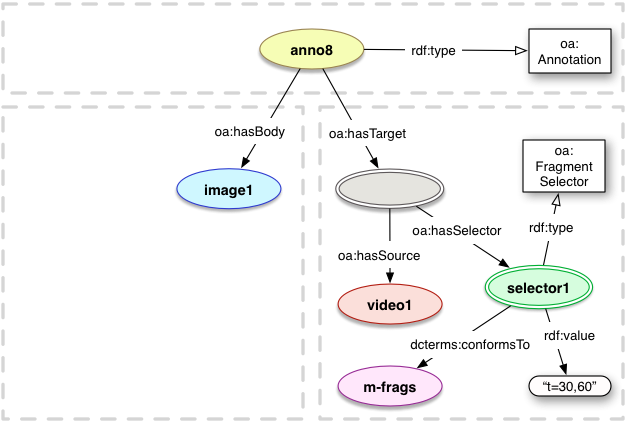
<http://example.org/anno7> a oa:Annotation ; oa:hasBody <http://example.org/image1> ; oa:hasTarget [ oa:hasSource <http://example.org/video1> ; oa:hasSelector [ a oa:FragmentSelector ; dcterms:conformsTo <http://www.w3.org/TR/media-frags/> ; rdf:value "t=30,60" ] ] .
HttpRequestState
The HttpRequestState class is used to record the HTTP request headers that a client SHOULD use to request the correct representation from the resource.
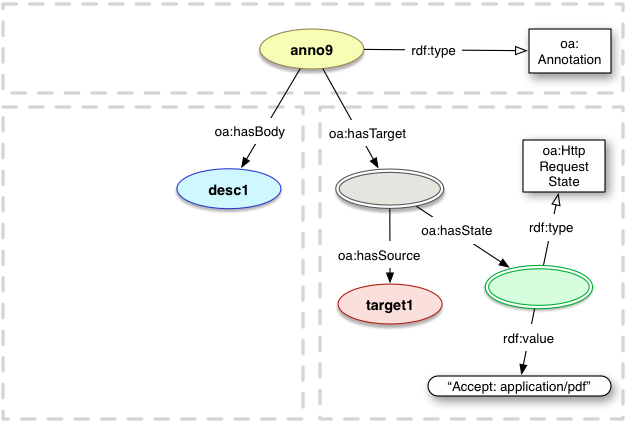
<http://example.org/anno8> a oa:Annotation ; oa:hasBody <http://example.org/description1> ; oa:hasTarget [ oa:hasSource <http://example.org/target1> ; oa:hasState [ a oa:HttpRequestState ; rdf:value "Accept: application/pdf" ] ] .
Motivation
The Motivation class is used to record the user's intent or motivation for the creation of the Annotation, or the inclusion of the body or target, that it is associated with.
- IRI: http://www.w3.org/ns/oa#Motivation
- Sub Class Of: skos:Concept
- Range Of: oa:motivatedBy, oa:hasPurpose

<http://example.org/anno9> a oa:Annotation ; oa:hasBody <http://example.org/description1> ; oa:hasTarget <http://example.com/resource1> ; oa:motivatedBy oa:describing .
RangeSelector
A Range Selector can be used to identify the beginning and the end of the selection by using other Selectors. The selection consists of everything from the beginning of the starting selector through to the beginning of the ending selector, but not including it.
- IRI: http://www.w3.org/ns/oa#RangeSelector
- Sub Class Of: oa:Selector
- Required Predicates: oa:hasStartSelector, oa:hasEndSelector, rdf:type
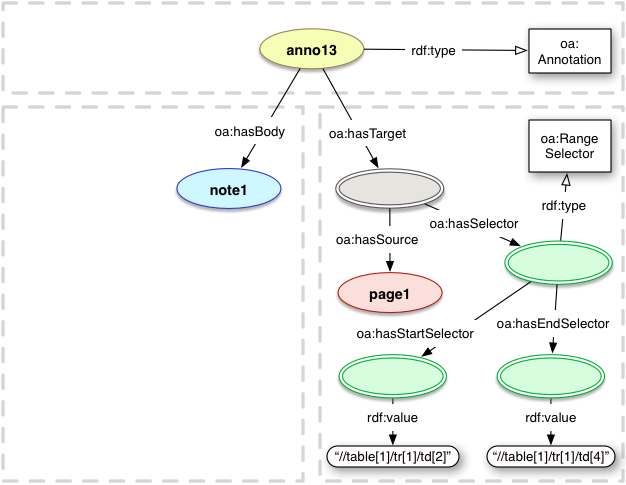
<http://example.org/anno10> a oa:Annotation ; oa:hasBody <http://example.org/note1> ; oa:hasTarget [ oa:hasSource <http://example.org/page1> ; oa:hasSelector [ a oa:RangeSelector ; oa:hasStartSelector [ a oa:XPathSelector ; rdf:value "//table[1]/tr[1]/td[2]" ] ; oa:hasEndSelector [ a oa:XPathSelector ; rdf:value "//table[1]/tr[1]/td[4]" ] ] ] .
ResourceSelection
Instances of the ResourceSelection class identify part (described by an oa:Selector) of another resource (referenced with oa:hasSource), possibly from a particular representation of a resource (described by an oa:State). Please note that ResourceSelection is not used directly in the Web Annotation model, but is provided as a separate class for further application profiles to use, separate from oa:SpecificResource which has many Annotation specific features.
- IRI: http://www.w3.org/ns/oa#ResourceSelection
- Required Predicates: oa:hasSource
- Recommended Predicates: oa:hasSelector, oa:hasState
Selector
A resource which describes the segment of interest in a representation of a Source resource, indicated with oa:hasSelector from the Specific Resource. This class is not used directly in the Annotation model, only its subclasses.
- IRI: http://www.w3.org/ns/oa#Selector
- Super Class Of: oa:FragmentSelector, oa:TextQuoteSelector, oa:TextPositionSelector, oa:DataPositionSelector, oa:SvgSelector
- Range Of: oa:hasSelector
SpecificResource
Instances of the SpecificResource class identify part of another resource (referenced with oa:hasSource), a particular representation of a resource, a resource with styling hints for renders, or any combination of these, as used within an Annotation.
- IRI: http://www.w3.org/ns/oa#SpecificResource
- Sub Class Of: oa:ResourceSelection
- Required Predicates: oa:hasSource
- Recommended Predicates: oa:hasSelector, oa:hasState, oa:hasPurpose
- Other Predicates: oa:hasScope, oa:styleClass
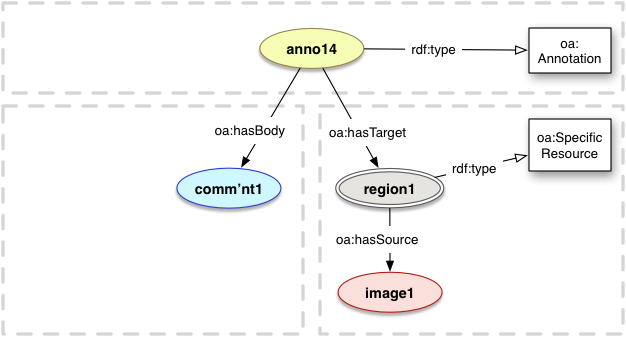
<http://example.org/anno11> a oa:Annotation ; oa:hasBody <http://example.org/comment1> ; oa:hasTarget <http://example.org/region1> . <http://example.org/region1> a oa:SpecificResource ; oa:hasSource <http://example.org/image1> .
State
A State describes the intended state of a resource as applied to the particular Annotation, and thus provides the information needed to retrieve the correct representation of that resource.
- IRI: http://www.w3.org/ns/oa#State
- Super Class Of: oa:HttpRequestState, oa:TimeState
- Range Of: oa:hasState
Style
A Style describes the intended styling of a resource as applied to the particular Annotation, and thus provides the information to ensure that rendering is consistent across implementations.
- IRI: http://www.w3.org/ns/oa#Style
- Super Class Of: oa:CssStyle
- Range Of: oa:styledBy
SvgSelector
An SvgSelector defines an area through the use of the Scalable Vector Graphics [SVG] standard. This allows the user to select a non-rectangular area of the content, such as a circle or polygon by describing the region using SVG. The SVG may be either embedded within the Annotation or referenced as an External Resource.
- IRI: http://www.w3.org/ns/oa#SvgSelector
- Sub Class Of: oa:Selector
- Required Predicates: rdf:type
- Other Predicates: rdf:value
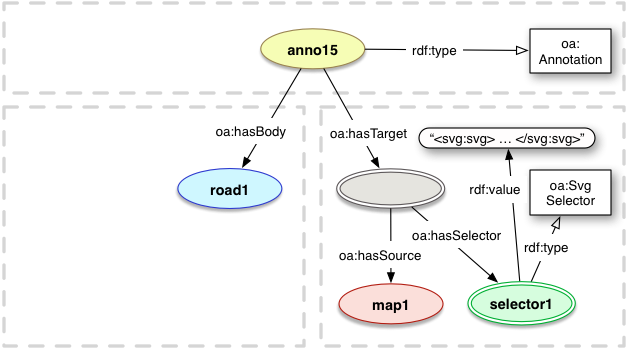
<http://example.org/anno12> a oa:Annotation ; oa:hasBody <http://example.org/road1> ; oa:hasTarget [ oa:hasSource <http://example.org/map1> ; oa:hasSelector [ a oa:SvgSelector ; rdf:value "<svg:svg> ... </svg:svg>" ] ] .
TextPositionSelector
The TextPositionSelector describes a range of text by recording the start and end positions of the selection in the stream. Position 0 would be immediately before the first character, position 1 would be immediately before the second character, and so on.
- IRI: http://www.w3.org/ns/oa#TextPositionSelector
- Sub Class Of: oa:Selector
- Required Predicates: oa:start, oa:end, rdf:type
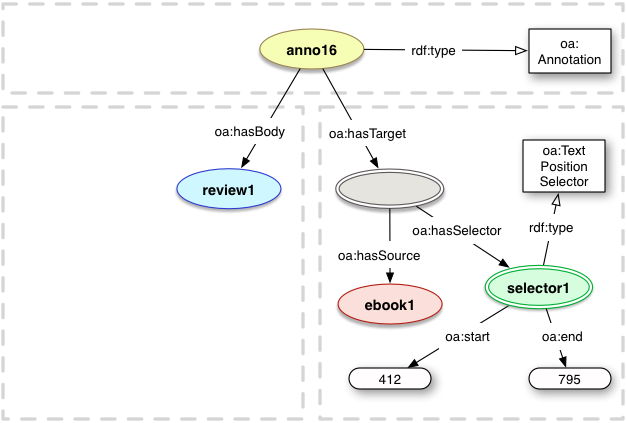
<http://example.org/anno13> a oa:Annotation ; oa:hasBody <http://example.org/review1> ; oa:hasTarget [ oa:hasSource <http://example.org/ebook1> ; oa:hasSelector [ a oa:TextPositionSelector ; oa:start 412 ; oa:end 795 ] ] .
TextQuoteSelector
The TextQuoteSelector describes a range of text by copying it, and including some of the text immediately before (a prefix) and after (a suffix) it to distinguish between multiple copies of the same sequence of characters.
- IRI: http://www.w3.org/ns/oa#TextQuoteSelector
- Sub Class Of: oa:Selector
- Required Predicates: rdf:type, oa:exact
- Recommended Predicates: oa:prefix, oa:suffix
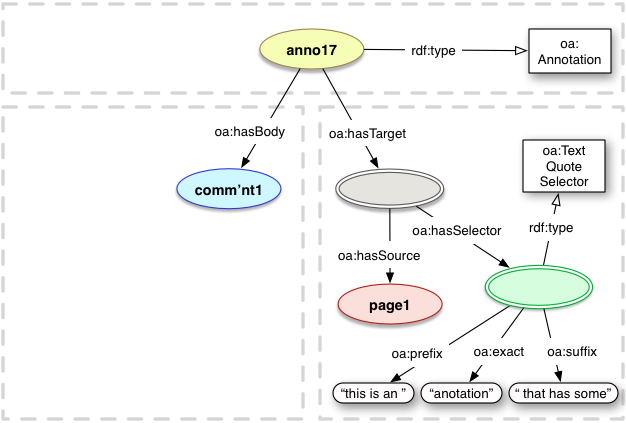
<http://example.org/anno14> a oa:Annotation ; oa:hasBody <http://example.org/comment1> ; oa:hasTarget [ oa:hasSource <http://example.org/page1> ; oa:hasSelector [ a oa:TextQuoteSelector ; oa:exact "anotation" ; oa:prefix "this is an " ; oa:suffix " that has some" ] ] .
TextualBody
- IRI: http://www.w3.org/ns/oa#TextualBody
- Equivalent Classes: as:Note
- Required Predicates: rdf:value
- Recommended Predicates: dc:format, dc:language, rdf:type
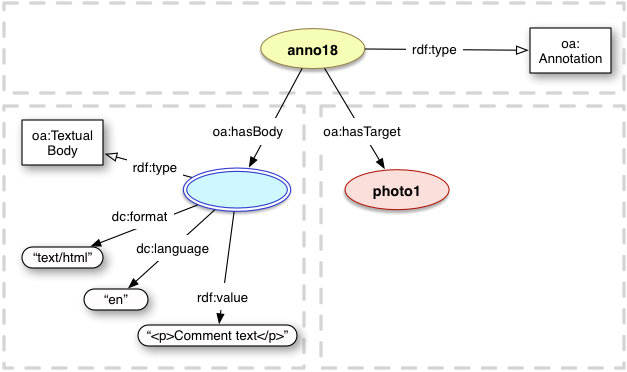
<http://example.org/anno15> a oa:Annotation ; oa:hasTarget <http://example.org/photo1> ; oa:hasBody [ a oa:TextualBody; rdf:value "<p>Comment text</p>" ; dc:language "en" ; dc:format "text/html" ] .
TimeState
A TimeState records the time at which the resource's state is appropriate for the Annotation, typically the time that the Annotation was created and/or a link to a persistent copy of the current version.
- IRI: http://www.w3.org/ns/oa#TimeState
- Sub Class Of: oa:State
- Required Predicates: rdf:type
- Recommended Predicates: oa:sourceDate, oa:cachedSource
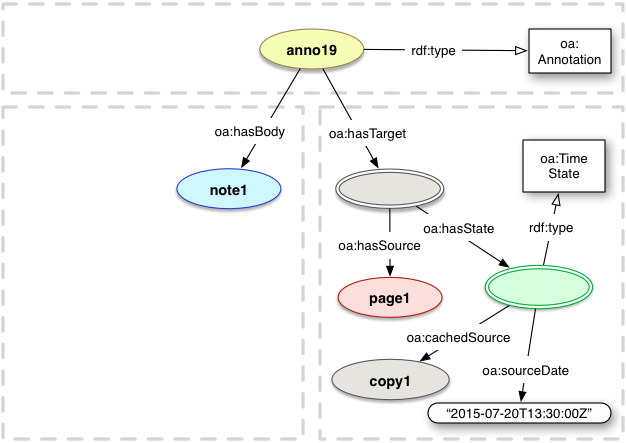
<http://example.org/anno16> a oa:Annotation ; oa:hasBody <http://example.org/note1> ; oa:hasTarget [ oa:hasSource <http://example.org/page1> ; oa:hasState [ a oa:TimeState ; oa:cachedSource <http://example.org/copy1> ; oa:sourceDate "2015-07-20T13:30:00Z" ] ] .
XPathSelector
An XPathSelector is used to select elements and content within a resource that supports the Document Object Model via a specified XPath value.
- IRI: http://www.w3.org/ns/oa#XPathSelector
- Sub Class Of: oa:Selector
- Required Predicates: rdf:value, rdf:type
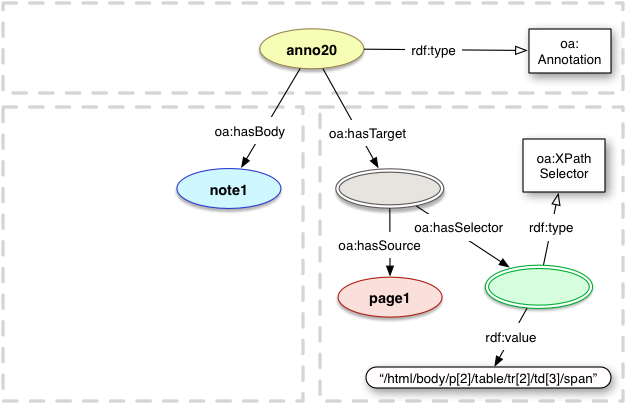
<http://example.org/anno17> a oa:Annotation ; oa:hasBody <http://example.org/note1> ; oa:hasTarget [ oa:hasSource <http://example.org/page1> ; oa:hasSelector [ a oa:XPathSelector ; rdf:value "/html/body/p[2]/table/tr[2]/td[3]/span" ] ] .
Properties
annotationService
The object of the relationship is the end point of a service that conforms to the [[!annotation-protocol]], and it may be associated with any resource. The expectation of asserting the relationship is that the object is the preferred service for maintaining annotations about the subject resource, according to the publisher of the relationship.
This relationship is intended to be used both within Linked Data descriptions and as the rel type of a Link, via HTTP Link Headers [[!rfc5988]] for binary resources and in HTML <link> elements. For more information about these, please see the Annotation Protocol specification [[!annotation-protocol]].
- IRI: http://www.w3.org/ns/oa#annotationService
<http://example.org/diagram.jpg> a dctypes:Image ; oa:annotationService <http://example.org/services/annotations/> .
bodyValue
The object of the predicate is a plain text string to be used as the content of the body of the Annotation. The value MUST be an xsd:string and that data type MUST NOT be expressed in the serialization. Note that language MUST NOT be associated with the value either as a language tag, as that is only available for rdf:langString.
- IRI: http://www.w3.org/ns/oa#bodyValue
- Domain: oa:Annotation
- Range: xsd:string
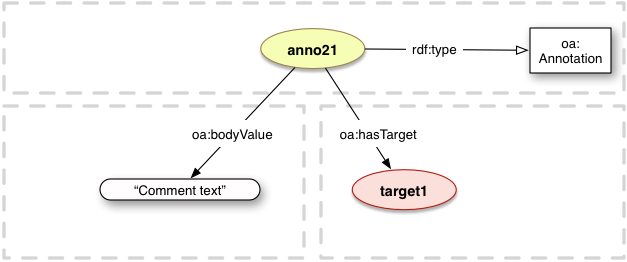
<http://example.org/anno18> a oa:Annotation ; oa:bodyValue "Comment text" ; oa:hasTarget <http://example.org/target1> .
cachedSource
A object of the relationship is a copy of the Source resource's representation, appropriate for the Annotation.
- IRI: http://www.w3.org/ns/oa#cachedSource
- Domain: oa:TimeState
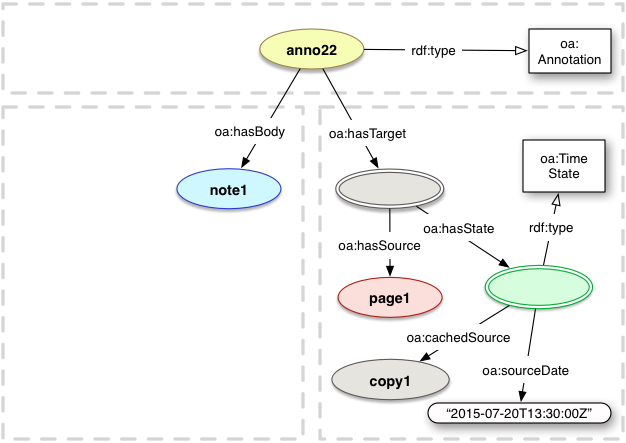
<http://example.org/anno19> a oa:Annotation ; oa:hasBody <http://example.org/note1> ; oa:hasTarget [ oa:hasSource <http://example.org/page1> ; oa:hasState [ a oa:TimeState ; oa:cachedSource <http://example.org/copy1> ; oa:sourceDate "2015-07-20T13:30:00Z" ] ] .
canonical
A object of the relationship is the canonical IRI that can always be used to deduplicate the Annotation, regardless of the current IRI used to access the representation.
- IRI: http://www.w3.org/ns/oa#canonical
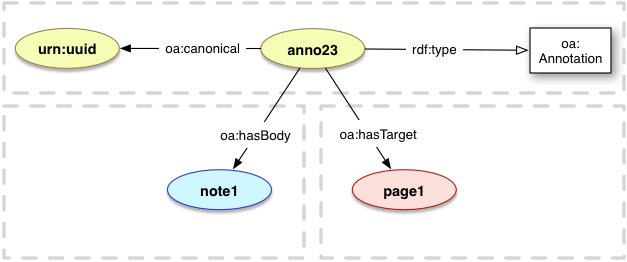
<http://example.org/anno20> a oa:Annotation ; oa:hasBody <http://example.org/note1> ; oa:hasTarget <http://example.org/page1> ; oa:canonical <urn:uuid:dbfb1861-0ecf-41ad-be94-a584e5c4f1df> .
end
The end property is used to convey the 0-based index of the end position of a range of content.
- IRI: http://www.w3.org/ns/oa#end
- Range: xsd:nonNegativeInteger

<http://example.org/anno21> a oa:Annotation ; oa:hasBody <http://example.org/note1> ; oa:hasTarget [ oa:hasSource <http://example.org/diskimg1> ; oa:hasSelector [ a oa:DataPositionSelector ; oa:start 4096 ; oa:end 4104 ] ] .
exact
The object of the predicate is a copy of the text which is being selected, after normalization.
- IRI: http://www.w3.org/ns/oa#exact
- Range: xsd:string
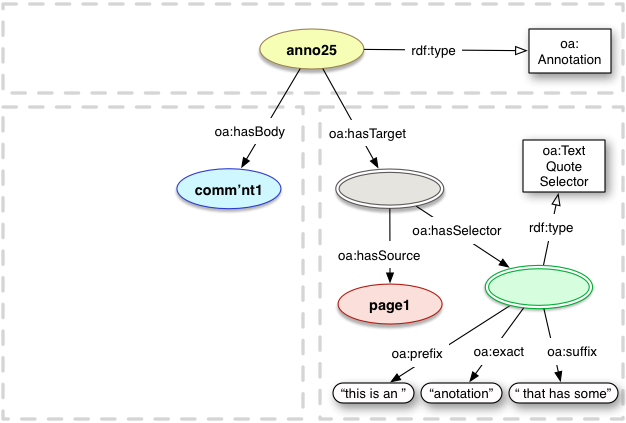
<http://example.org/anno22> a oa:Annotation ; oa:hasBody <http://example.org/comment1> ; oa:hasTarget [ oa:hasSource <http://example.org/page1> ; oa:hasSelector [ a oa:TextQuoteSelector ; oa:exact "anotation" ; oa:prefix "this is an " ; oa:suffix " that has some" ] ] .
hasBody
The object of the relationship is a resource that is a body of the Annotation.
- IRI: http://www.w3.org/ns/oa#hasBody
- Domain: oa:Annotation
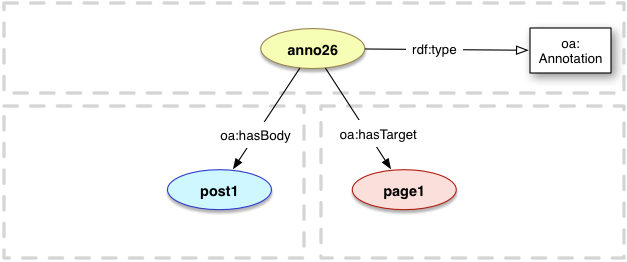
<http://example.org/anno23> a oa:Annotation ; oa:hasBody <http://example.org/post1> ; oa:hasTarget <http://example.com/page1> .
hasEndSelector
The relationship between a RangeSelector and the Selector that describes the end position of the range.
- IRI: http://www.w3.org/ns/oa#hasEndSelector
- Domain: oa:RangeSelector
- Range: oa:Selector
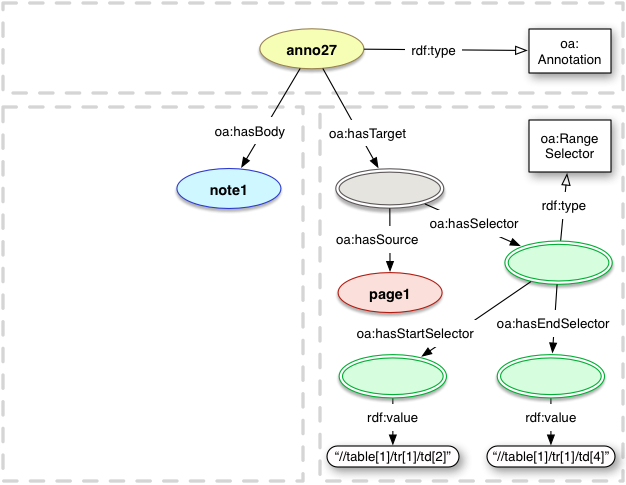
<http://example.org/anno24> a oa:Annotation ; oa:hasBody <http://example.org/note1> ; oa:hasTarget [ oa:hasSource <http://example.org/page1> ; oa:hasSelector [ a oa:RangeSelector ; oa:hasStartSelector [ a oa:XPathSelector ; rdf:value "//table[1]/tr[1]/td[2]" ] ; oa:hasEndSelector [ a oa:XPathSelector ; rdf:value "//table[1]/tr[1]/td[4]" ] ] ] .
hasPurpose
The purpose served by the resource in the Annotation.
- IRI: http://www.w3.org/ns/oa#hasPurpose
- Range: oa:Motivation
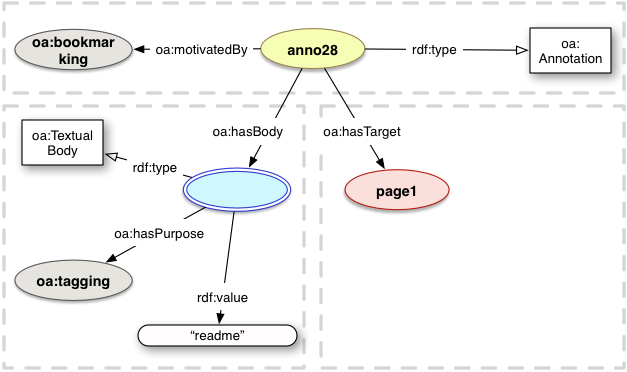
<http://example.org/anno25> a oa:Annotation ; oa:motivatedBy oa:bookmarking ; oa:hasBody [ a oa:TextualBody ; rdf:value "readme" ; oa:hasPurpose oa:tagging ] ; oa:hasTarget <http://example.org/page1> .
hasScope
The scope or context in which the resource is used within the Annotation.
- IRI: http://www.w3.org/ns/oa#hasScope
- Domain: oa:SpecificResource
- Equivalent Properties: as:context
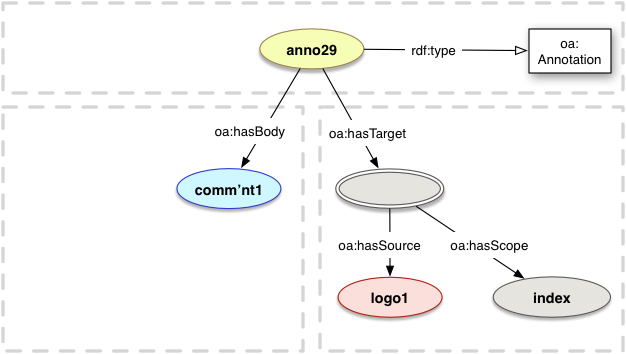
<http://example.org/anno26> a oa:Annotation ; oa:hasBody <http://example.org/comment1> ; oa:hasTarget [ oa:hasSource <http://example.org/logo1.jpg> ; oa:hasScope <http://example.org/index.html> ] .
hasSelector
The object of the relationship is a Selector that describes the segment or region of interest within the source resource. Please note that the domain (oa:ResourceSelection) is not used directly in the Web Annotation model.
- IRI: http://www.w3.org/ns/oa#hasSelector
- Domain: oa:ResourceSelection
- Range: oa:Selector
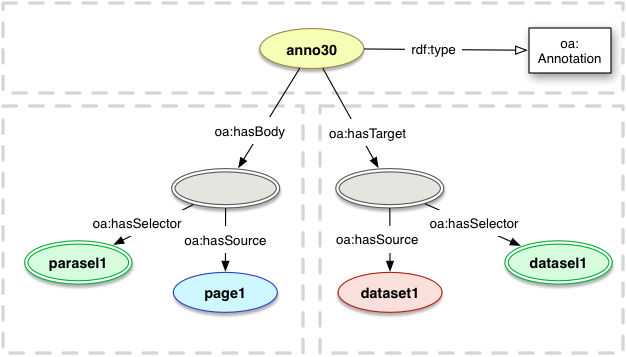
<http://example.org/anno27> a oa:Annotation ; oa:hasBody [ oa:hasSource <http://example.org/page1> ; oa:hasSelector <http://example.org/paraselector1> ] ; oa:hasTarget [ oa:hasSource <http://example.com/dataset1> ; oa:hasSelector <http://example.org/dataselector1> ] .
hasSource
The resource that the ResourceSelection, or its subclass SpecificResource, is refined from, or more specific than. Please note that the domain (oa:ResourceSelection) is not used directly in the Web Annotation model.
- IRI: http://www.w3.org/ns/oa#hasSource
- Domain: oa:ResourceSelection
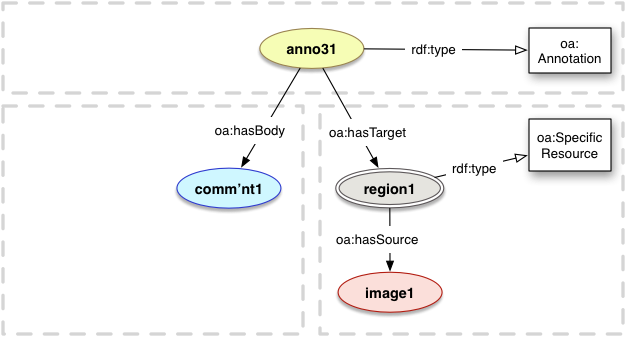
<http://example.org/anno28> a oa:Annotation ; oa:hasBody <http://example.org/comment1> ; oa:hasTarget <http://example.org/region1> . <http://example.org/region1> a oa:SpecificResource ; oa:hasSource <http://example.org/image1> .
hasStartSelector
The relationship between a RangeSelector and the Selector that describes the start position of the range.
- IRI: http://www.w3.org/ns/oa#hasStartSelector
- Domain: oa:RangeSelector
- Range: oa:Selector
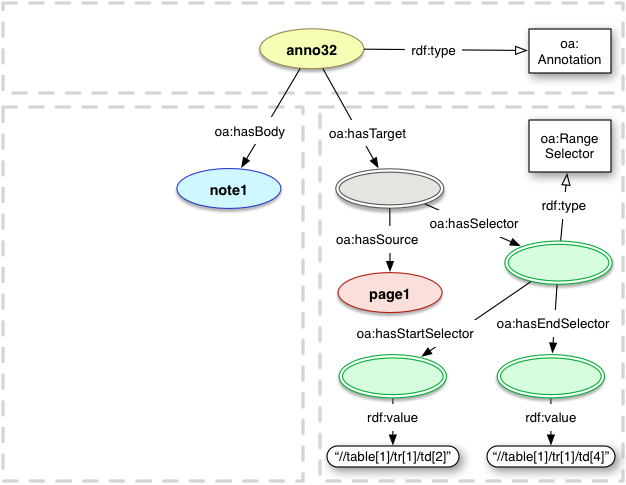
<http://example.org/anno29> a oa:Annotation ; oa:hasBody <http://example.org/note1> ; oa:hasTarget [ oa:hasSource <http://example.org/page1> ; oa:hasSelector [ a oa:RangeSelector ; oa:hasStartSelector [ a oa:XPathSelector ; rdf:value "//table[1]/tr[1]/td[2]" ] ; oa:hasEndSelector [ a oa:XPathSelector ; rdf:value "//table[1]/tr[1]/td[4]" ] ] ] .
hasState
The relationship between the ResourceSelection, or its subclass SpecificResource, and a State resource. Please note that the domain (oa:ResourceSelection) is not used directly in the Web Annotation model.
- IRI: http://www.w3.org/ns/oa#hasState
- Domain: oa:ResourceSelection
- Range: oa:State
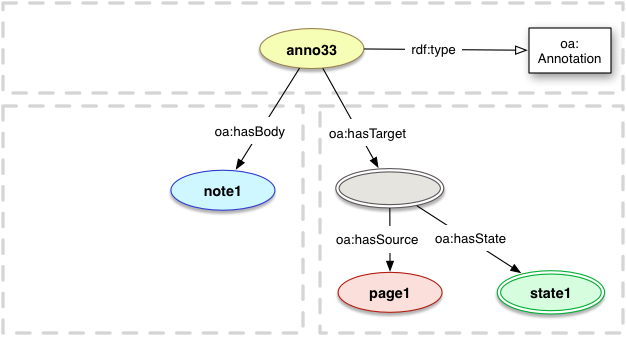
<http://example.org/anno30> a oa:Annotation ; oa:hasBody <http://example.org/note1> ; oa:hasTarget [ oa:hasState <http://example.org/state1> ; oa:hasSource <http://example.org/page1> ] .
hasTarget
The relationship between an Annotation and its Target.
- IRI: http://www.w3.org/ns/oa#hasTarget
- Domain: oa:Annotation
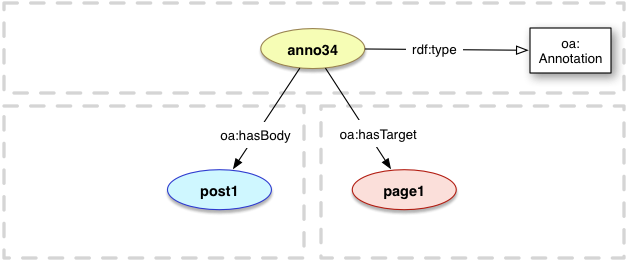
<http://example.org/anno31> a oa:Annotation ; oa:hasBody <http://example.org/post1> ; oa:hasTarget <http://example.com/page1> .
motivatedBy
The relationship between an Annotation and a Motivation that describes the reason for the Annotation's creation.
- IRI: http://www.w3.org/ns/oa#motivatedBy
- Domain: oa:Annotation
- Range: oa:Motivation
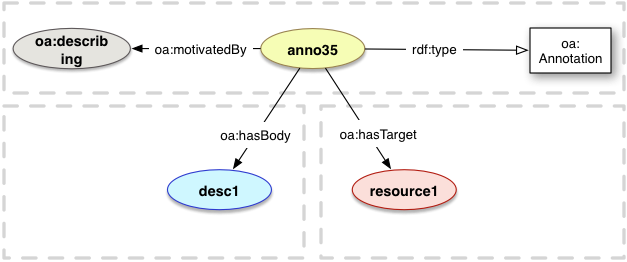
<http://example.org/anno32> a oa:Annotation ; oa:hasBody <http://example.org/description1> ; oa:hasTarget <http://example.com/resource1> ; oa:motivatedBy oa:describing .
prefix
The object of the property is a snippet of content that occurs immediately before the content which is being selected by the Selector.
- IRI: http://www.w3.org/ns/oa#prefix
- Range: xsd:string
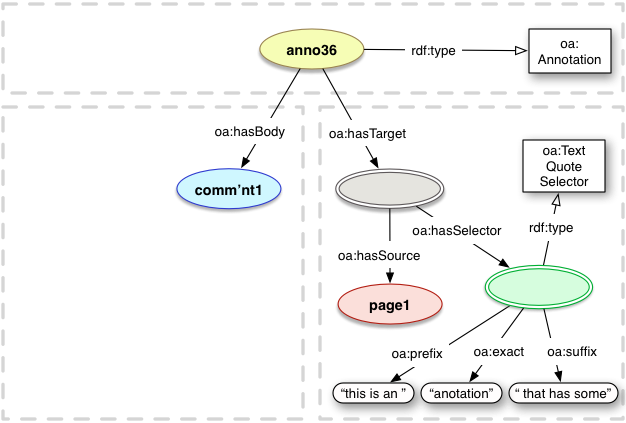
<http://example.org/anno33> a oa:Annotation ; oa:hasBody <http://example.org/comment1> ; oa:hasTarget [ oa:hasSource <http://example.org/page1> ; oa:hasSelector [ a oa:TextQuoteSelector ; oa:exact "anotation" ; oa:prefix "this is an " ; oa:suffix " that has some" ] ] .
processingLanguage
The object of the property is the language that should be used for textual processing algorithms when dealing with the content of the resource, including hyphenation, line breaking, which font to use for rendering and so forth. The value must follow the recommendations of [[!BCP47]].
- IRI: http://www.w3.org/ns/oa#processingLanguage
- Sub Property Of: dc:language
- Range: xsd:string
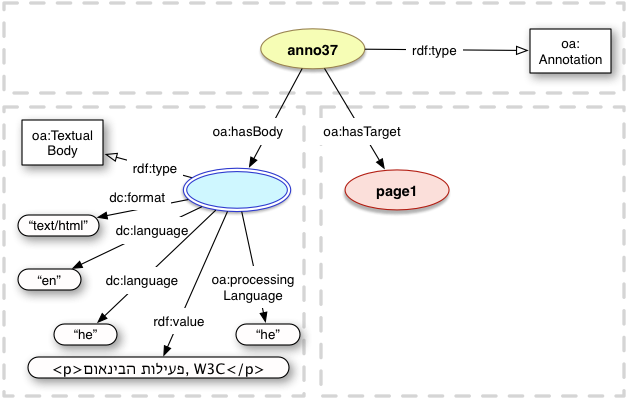
<http://example.org/anno34> a oa:Annotation ; oa:hasBody [ a oa:TextualBody ; rdf:value "<p>פעילות הבינאום, W3C</p>" ; dc:format "text/html" ; dc:language "en", "he" ; oa:processingLanguage "he" ] ; oa:hasTarget <http://example.org/page1> .
refinedBy
The relationship between a Selector and another Selector or a State and a Selector or State that should be applied to the results of the first to refine the processing of the source resource.
- IRI: http://www.w3.org/ns/oa#refinedBy
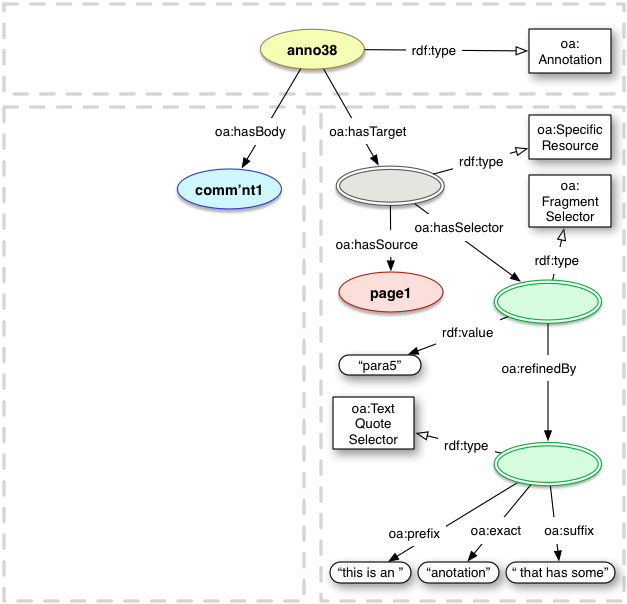
<http://example.org/anno35> a oa:Annotation ; oa:hasBody <http://example.org/comment1> ; oa:hasTarget [ a oa:SpecificResource ; oa:hasSource <http://example.org/page1> ; oa:hasSelector [ a oa:FragmentSelector ; rdf:value "para5" ; oa:refinedBy [ a oa:TextQuoteSelector ; oa:exact "selected text" ; oa:prefix "text before the " ; oa:suffix "and text after it" ] ] ] .
renderedVia
A system that was used by the application that created the Annotation to render the resource.
- IRI: http://www.w3.org/ns/oa#renderedVia
- Domain: oa:SpecificResource
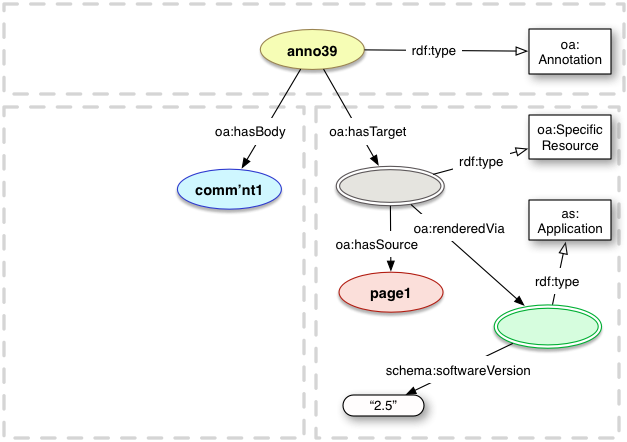
<http://example.org/anno36> a oa:Annotation ; oa:hasBody <http://example.org/comment1> ; oa:hasTarget [ a oa:SpecificResource ; oa:hasSource <http://example.org/page1> ; oa:renderedVia [ a as:Application ; schema:softwareVersion "2.5" ] ] .
sourceDate
The timestamp at which the Source resource should be interpreted as being applicable to the Annotation.
- IRI: http://www.w3.org/ns/oa#sourceDate
- Domain: oa:TimeState
- Range: xsd:dateTime
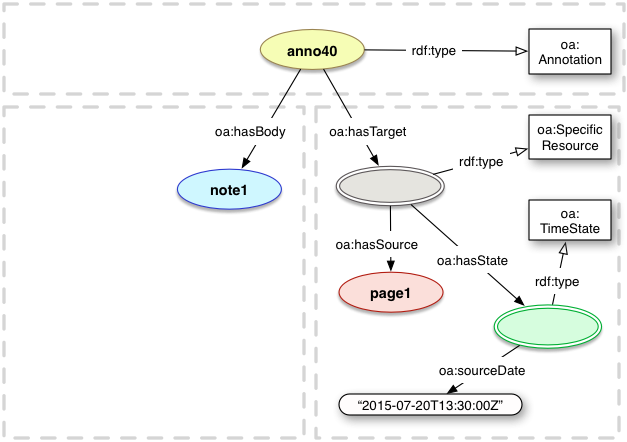
<http://example.org/anno37> a oa:Annotation ; oa:hasBody <http://example.org/note1> ; oa:hasTarget [ oa:hasSource <http://example.org/page1> ; oa:hasState [ a oa:TimeState ; oa:sourceDate "2015-07-20T13:30:00Z" ] ] .
sourceDateEnd
The end timestamp of the interval over which the Source resource should be interpreted as being applicable to the Annotation.
- IRI: http://www.w3.org/ns/oa#sourceDate
- Domain: oa:TimeState
- Range: xsd:dateTime
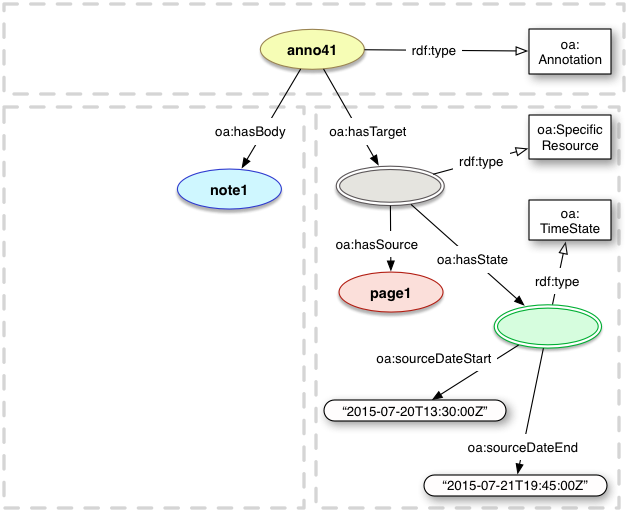
<http://example.org/anno38> a oa:Annotation ; oa:hasBody <http://example.org/note1> ; oa:hasTarget [ oa:hasSource <http://example.org/page1> ; oa:hasState [ a oa:TimeState ; oa:sourceDateStart "2015-07-20T13:30:00Z" ; oa:sourceDateEnd "2015-07-21T19:45:00Z" ] ] .
sourceDateStart
The start timestamp of the interval over which the Source resource should be interpreted as being applicable to the Annotation.
- IRI: http://www.w3.org/ns/oa#sourceDate
- Domain: oa:TimeState
- Range: xsd:dateTime
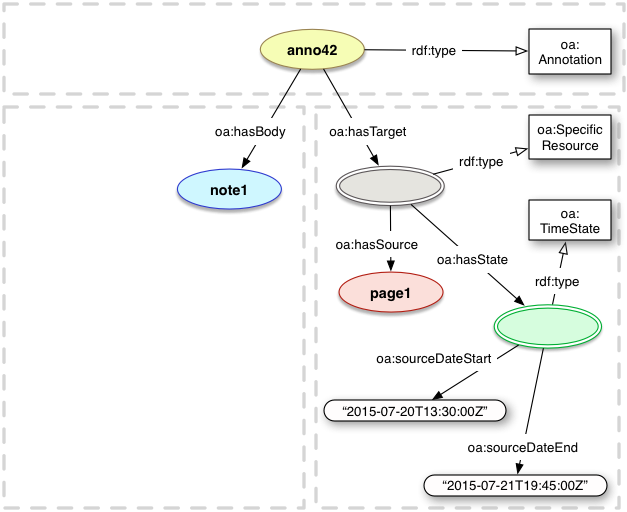
<http://example.org/anno39> a oa:Annotation ; oa:hasBody <http://example.org/note1> ; oa:hasTarget [ oa:hasSource <http://example.org/page1> ; oa:hasState [ a oa:TimeState ; oa:sourceDateStart "2015-07-20T13:30:00Z" ; oa:sourceDateEnd "2015-07-21T19:45:00Z" ] ] .
start
The start position in a 0-based index at which a range of content is selected from the data in the source resource.
- IRI: http://www.w3.org/ns/oa#start
- Range: xsd:nonNegativeInteger

<http://example.org/anno40> a oa:Annotation ; oa:hasBody <http://example.org/review1> ; oa:hasTarget [ oa:hasSource <http://example.org/ebook1> ; oa:hasSelector [ a oa:TextPositionSelector ; oa:start 412 ; oa:end 795 ] ] .
styleClass
The name of the class used in the CSS description referenced from the Annotation that should be applied to the Specific Resource.
- IRI: http://www.w3.org/ns/oa#styleClass
- Domain: oa:SpecificResource
- Range: xsd:string
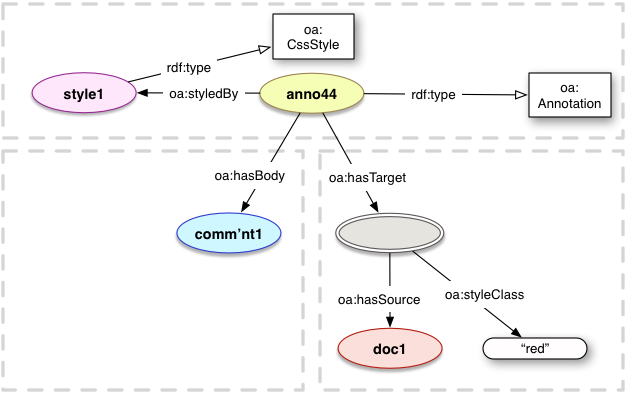
<http://example.org/anno41> a oa:Annotation ; oa:hasBody <http://example.org/comment1> ; oa:styledBy <http://example.org/style1> ; oa:hasTarget [ oa:hasSource <http://example.org/document1> ; oa:styleClass "red" ] . <http://example.org/style1> a oa:CssStyle .
styledBy
A reference to a Stylesheet that should be used to apply styles to the Annotation rendering.
- IRI: http://www.w3.org/ns/oa#styledBy
- Domain: oa:Annotation
- Range: oa:Style
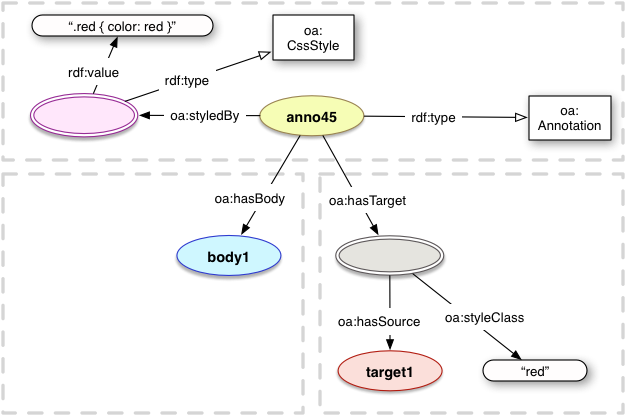
<http://example.org/anno42> a oa:Annotation ; oa:hasBody <http://example.org/body1> ; oa:styledBy [ a oa:CssStyle ; rdf:value ".red { color: red }" ] ; oa:hasTarget [ oa:hasSource <http://example.org/target1> ; oa:styleClass "red" ] .
suffix
The snippet of text that occurs immediately after the text which is being selected.
- IRI: http://www.w3.org/ns/oa#suffix
- Range: xsd:string
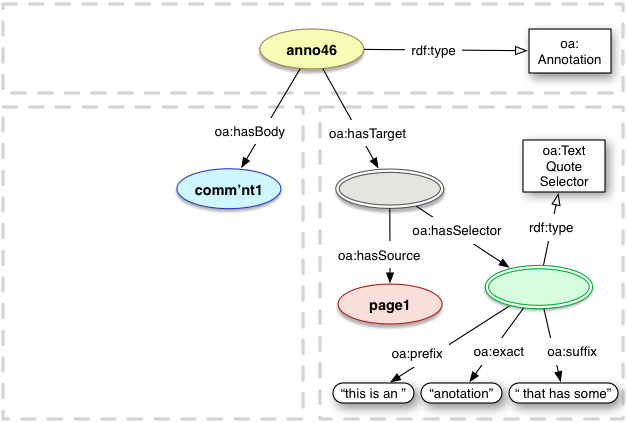
<http://example.org/anno43> a oa:Annotation ; oa:hasBody <http://example.org/comment1> ; oa:hasTarget [ oa:hasSource <http://example.org/page1> ; oa:hasSelector [ a oa:TextQuoteSelector ; oa:exact "anotation" ; oa:prefix "this is an " ; oa:suffix " that has some" ] ] .
textDirection
The direction of the text of the subject resource. There MUST only be one text direction associated with any given resource.
- IRI: http://www.w3.org/ns/oa#textDirection
- Range: oa:Direction
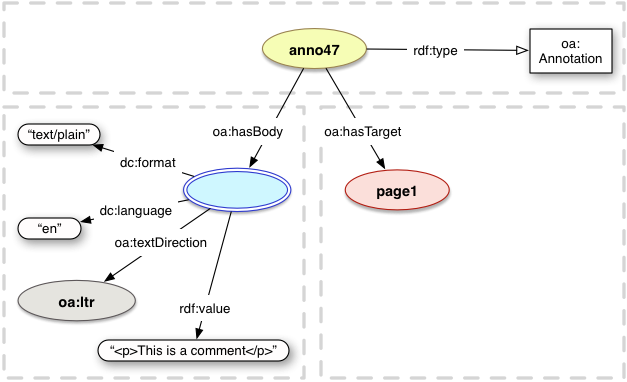
<http://example.org/anno44> a oa:Annotation ; oa:hasBody [ rdf:value "This is a comment" ; dc:language "en" ; dc:format "text/plain" ; oa:textDirection oa:ltr ] ; oa:hasTarget <http://example.org/page1> .
via
A object of the relationship is a resource from which the source resource was retrieved by the providing system.
- IRI: http://www.w3.org/ns/oa#via
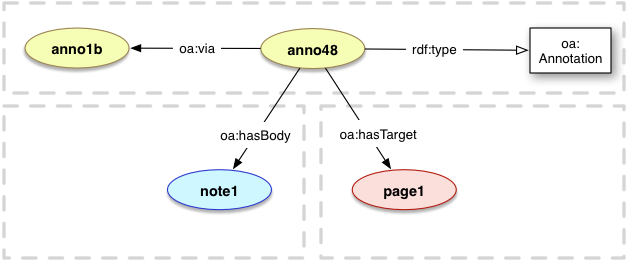
<http://example.org/anno45> a oa:Annotation ; oa:hasBody <http://example.org/note1> ; oa:hasTarget <http://example.org/page1> ; oa:via <http://other.example.com/anno1b> .
Named Individuals
assessing
The motivation for when the user intends to provide an assessment about the Target resource.
- IRI: http://www.w3.org/ns/oa#assessing
- Instance Of: oa:Motivation
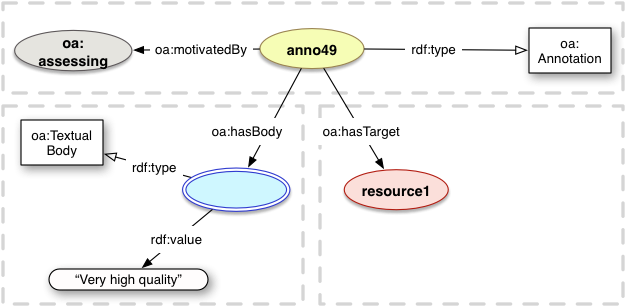
<http://example.org/anno46> a oa:Annotation ; oa:hasBody [ a oa:TextualBody ; rdf:value "Very high quality" ] ; oa:hasTarget <http://example.com/resource1> ; oa:motivatedBy oa:assessing .
bookmarking
The motivation for when the user intends to create a bookmark to the Target or part thereof.
- IRI: http://www.w3.org/ns/oa#bookmarking
- Instance Of: oa:Motivation
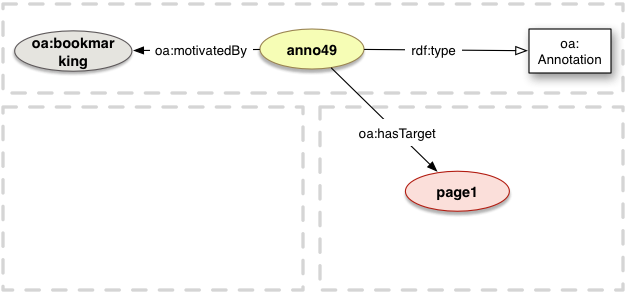
<http://example.org/anno47> a oa:Annotation ; oa:hasTarget <http://example.com/page1> ; oa:motivatedBy oa:bookmarking .
classifying
The motivation for when the user intends to that classify the Target as something.
- IRI: http://www.w3.org/ns/oa#classifying
- Instance Of: oa:Motivation
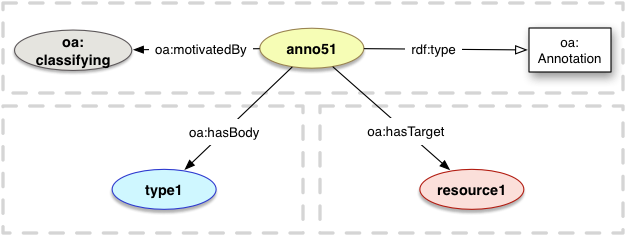
<http://example.org/anno48> a oa:Annotation ; oa:hasBody <http://example.org/type1> ; oa:hasTarget <http://example.com/resource1> ; oa:motivatedBy oa:classifying .
commenting
The motivation for when the user intends to comment about the Target.
- IRI: http://www.w3.org/ns/oa#commenting
- Instance Of: oa:Motivation
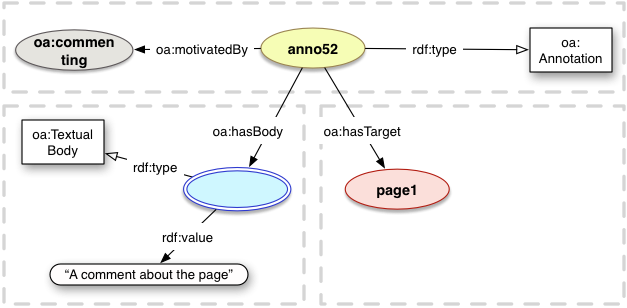
<http://example.org/anno49> a oa:Annotation ; oa:hasBody [ a oa:TextualBody ; rdf:value "A comment about the page" ] ; oa:hasTarget <http://example.com/page1> ; oa:motivatedBy oa:commenting .
describing
The motivation for when the user intends to describe the Target, as opposed to a comment about them.
- IRI: http://www.w3.org/ns/oa#describing
- Instance Of: oa:Motivation
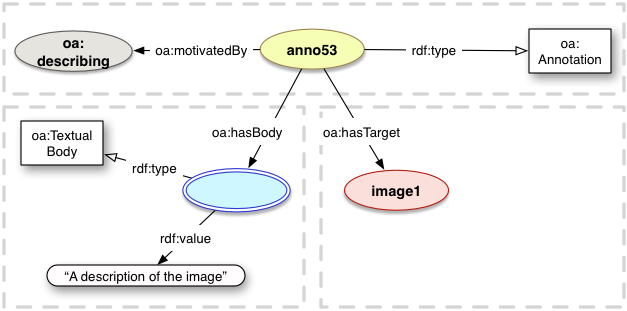
<http://example.org/anno50> a oa:Annotation ; oa:hasBody [ a oa:TextualBody ; rdf:value "A description of the image" ] ; oa:hasTarget <http://example.com/image1> ; oa:motivatedBy oa:describing .
editing
The motivation for when the user intends to request a change or edit to the Target resource.
- IRI: http://www.w3.org/ns/oa#editing
- Instance Of: oa:Motivation

<http://example.org/anno51> a oa:Annotation ; oa:hasBody [ a oa:TextualBody ; rdf:value "Editorial suggestion" ] ; oa:hasTarget <http://example.com/text1> ; oa:motivatedBy oa:editing .
highlighting
The motivation for when the user intends to highlight the Target resource or segment of it.
- IRI: http://www.w3.org/ns/oa#highlighting
- Instance Of: oa:Motivation
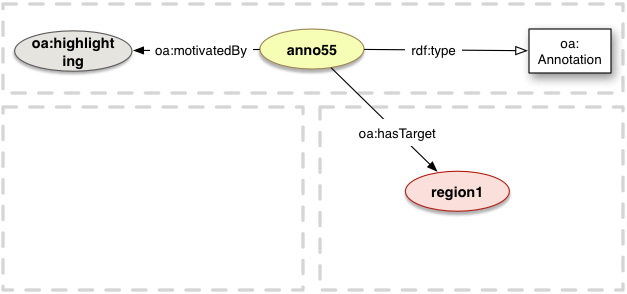
<http://example.org/anno52> a oa:Annotation ; oa:hasTarget <http://example.com/region1> ; oa:motivatedBy oa:highlighting .
identifying
The motivation for when the user intends to assign an identity to the Target or identify what is being depicted or described in the Target.
- IRI: http://www.w3.org/ns/oa#identifying
- Instance Of: oa:Motivation
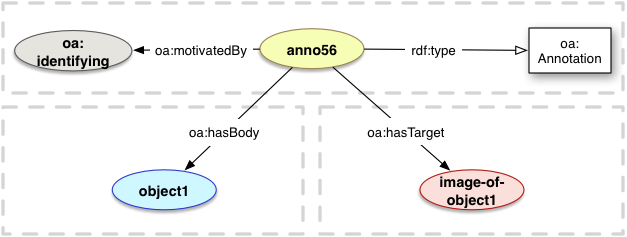
<http://example.org/anno53> a oa:Annotation ; oa:hasBody <http://example.com/identities/object1> ; oa:hasTarget <http://example.com/image-of-object1> ; oa:motivatedBy oa:identifying .
linking
The motivation for when the user intends to link to a resource related to the Target.
- IRI: http://www.w3.org/ns/oa#linking
- Instance Of: oa:Motivation
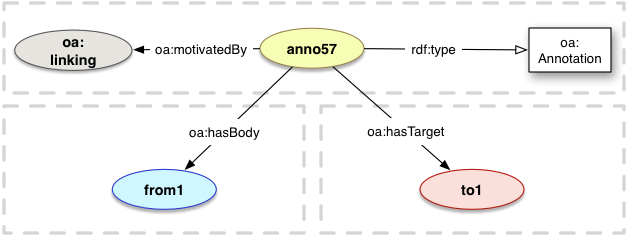
<http://example.org/anno54> a oa:Annotation ; oa:hasBody <http://example.org/from1> ; oa:hasTarget <http://example.com/to1> ; oa:motivatedBy oa:linking .
moderating
The motivation for when the user intends to assign some value or quality to the Target.
- IRI: http://www.w3.org/ns/oa#moderating
- Instance Of: oa:Motivation
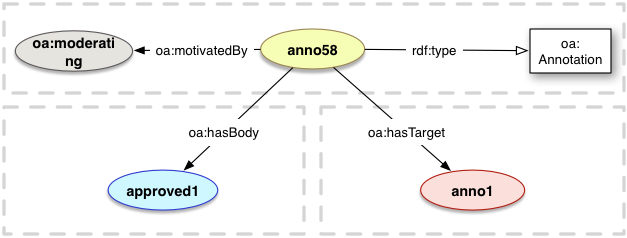
<http://example.org/anno55> a oa:Annotation ; oa:hasBody <http://example.org/tags/approved1> ; oa:hasTarget <http://example.com/anno1> ; oa:motivatedBy oa:moderating .
questioning
The motivation for when the user intends to ask a question about the Target.
- IRI: http://www.w3.org/ns/oa#questioning
- Instance Of: oa:Motivation
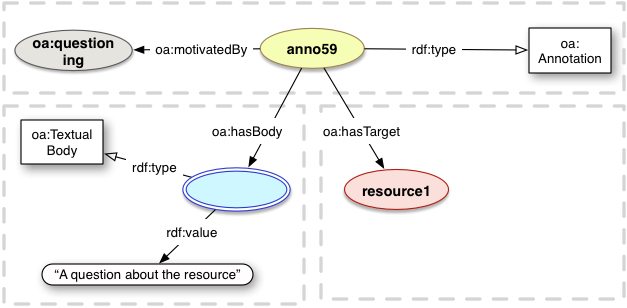
<http://example.org/anno56> a oa:Annotation ; oa:hasBody [ a oa:TextualBody ; rdf:value "A question about the resource" ] ; oa:hasTarget <http://example.com/resource1> ; oa:motivatedBy oa:questioning .
replying
The motivation for when the user intends to reply to a previous statement, either an Annotation or another resource.
- IRI: http://www.w3.org/ns/oa#replying
- Instance Of: oa:Motivation
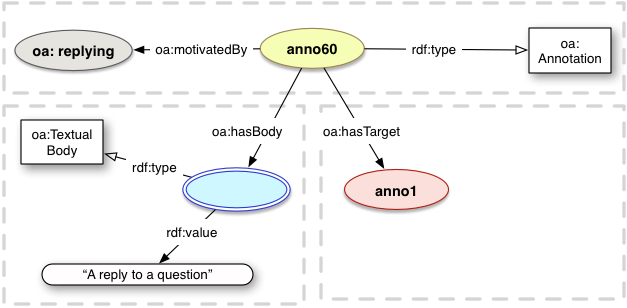
<http://example.org/anno57> a oa:Annotation ; oa:hasBody [ a oa:TextualBody ; rdf:value "A reply to a question" ] ; oa:hasTarget <http://example.com/anno1> ; oa:motivatedBy oa:replying .
tagging
The motivation for when the user intends to associate a tag with the Target.
- IRI: http://www.w3.org/ns/oa#tagging
- Instance Of: oa:Motivation
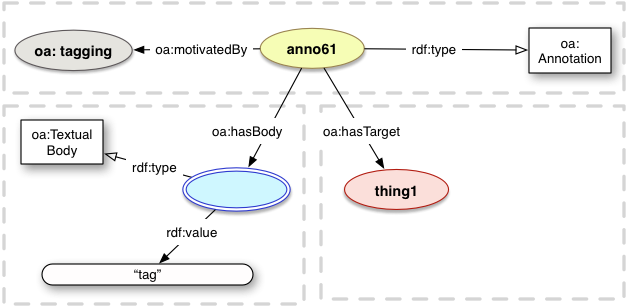
<http://example.org/anno58> a oa:Annotation ; oa:hasBody [ a oa:TextualBody ; rdf:value "tag" ] ; oa:hasTarget <http://example.com/thing1> ; oa:motivatedBy oa:tagging .
autoDirection
The direction of text that should be automatically determined from the content.
- IRI: http://www.w3.org/ns/oa#autoDirection
- Instance Of: oa:Direction
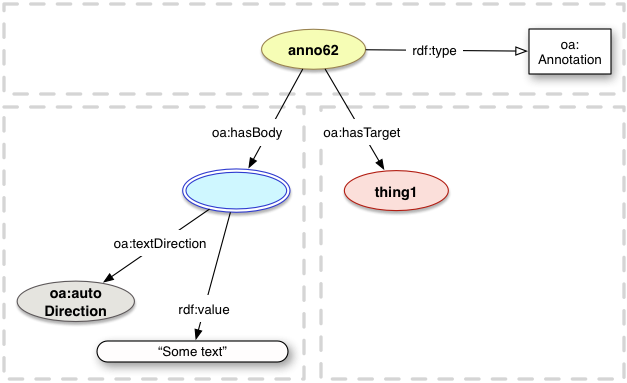
<http://example.org/anno59> a oa:Annotation ; oa:hasBody [ a oa:TextualBody ; rdf:value "Some text" ; oa:textDirection oa:autoDirection ] ; oa:hasTarget <http://example.com/thing1> .
ltrDirection
The direction of text that is read from left to right.
- IRI: http://www.w3.org/ns/oa#ltrDirection
- Instance Of: oa:Direction
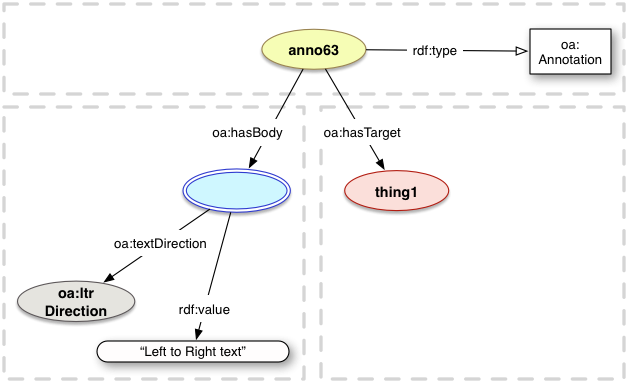
<http://example.org/anno60> a oa:Annotation ; oa:hasBody [ a oa:TextualBody ; rdf:value "Left to Right text" ; oa:textDirection oa:ltrDirection ] ; oa:hasTarget <http://example.com/thing1> .
rtlDirection
The direction of text that is read from right to left.
- IRI: http://www.w3.org/ns/oa#rtlDirection
- Instance Of: oa:Direction
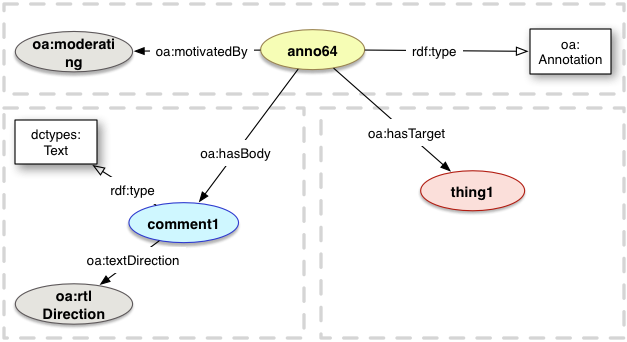
<http://example.org/anno61> a oa:Annotation ; oa:hasBody <http://example.org/ar/comment1> ; oa:hasTarget <http://example.com/thing1> . <http://example.org/ar/comment1> a dctypes:Text ; oa:textDirection oa:rtlDirection .
PreferContainedDescriptions
An IRI to signal the client prefers to receive full descriptions of the Annotations from a container, not just their IRIs.
- IRI: http://www.w3.org/ns/oa#PreferContainedDescriptions
- Instance Of: rdfs:Resource
GET /annotations/ HTTP/1.1 Host: example.org Accept: application/ld+json; profile="http://www.w3.org/ns/anno.jsonld" Prefer: return=representation;include="http://www.w3.org/ns/ldp#PreferContainedDescriptions"
PreferContainedIRIs
An IRI to signal that the client prefers to receive only the IRIs of the Annotations from a container, not their full descriptions.
- IRI: http://www.w3.org/ns/oa#PreferContainedIRIs
- Instance Of: rdfs:Resource
GET /annotations/ HTTP/1.1 Host: example.org Accept: application/ld+json; profile="http://www.w3.org/ns/anno.jsonld" Prefer: return=representation;include="http://www.w3.org/ns/ldp#PreferContainedIRIs"
